SLUSAL5C December 2012 – June 2016
PRODUCTION DATA.
- 1 Features
- 2 Applications
- 3 Description
- 4 Revision History
- 5 Pin Configuration and Functions
-
6 Specifications
- 6.1 Absolute Maximum Ratings
- 6.2 ESD Ratings
- 6.3 Thermal Information
- 6.4 Recommended Operating Conditions
- 6.5 Supply Current
- 6.6 Digital Input and Output DC Characteristics
- 6.7 Power-on Reset
- 6.8 2.5-V LDO Regulator
- 6.9 Internal Clock Oscillators
- 6.10 ADC (Temperature and Cell Measurement) Characteristics
- 6.11 Integrating ADC (Coulomb Counter) Characteristics
- 6.12 Data Flash Memory Characteristics
- 6.13 I2C-Compatible Interface Communication Timing Characteristics
- 6.14 Typical Characteristics
- 7 Detailed Description
- 8 Application and Implementation
- 9 Power Supply Recommendations
- 10Layout
- 11Device and Documentation Support
- 12Mechanical, Packaging, and Orderable Information
Package Options
Mechanical Data (Package|Pins)
- YZF|15
Thermal pad, mechanical data (Package|Pins)
Orderable Information
7 Detailed Description
7.1 Overview
Battery fuel gauging with the bq27530-G1 requires only PACK+ (P+), PACK– (P–), and Thermistor (T) connections to a removable battery pack or embedded battery circuit. The CSP option is a 15-ball package in the dimensions of 2.61 mm × 1.96 mm with 0.5 mm lead pitch. It is ideal for space constrained applications.
The bq27530-G1 accurately predicts the battery capacity and other operational characteristics of a single Li-based rechargeable cell. It can be interrogated by a system processor to provide cell information, such as time-to-empty (TTE), and state-of-charge (SOC) as well as SOC interrupt signal to the host.
The bq27530-G1 can control a bq2416x Charger IC without the intervention from an application system processor. Using the bq27530-G1 and bq2416x chipset, batteries can be charged with the typical constant-current, constant voltage (CCCV) profile or charged using a Multi-Level Charging (MLC) algorithm.
The fuel gauge can also be configured to suggest charge voltage and current values to the system so that the host can control a charger that is not part of the bq2416x charger family.
NOTE
FORMATTING CONVENTIONS IN THIS DOCUMENT:
Commands: italics with parentheses and no breaking spaces, e.g., RemainingCapacity()
Data flash: italics, bold, and breaking spaces, e.g., Design Capacity
Register bits and flags: brackets and italics, e.g., [TDA]
Data flash bits: brackets, italics and bold, e.g., [LED1]
Modes and states: ALL CAPITALS, e.g., UNSEALED mode.
7.2 Functional Block Diagram
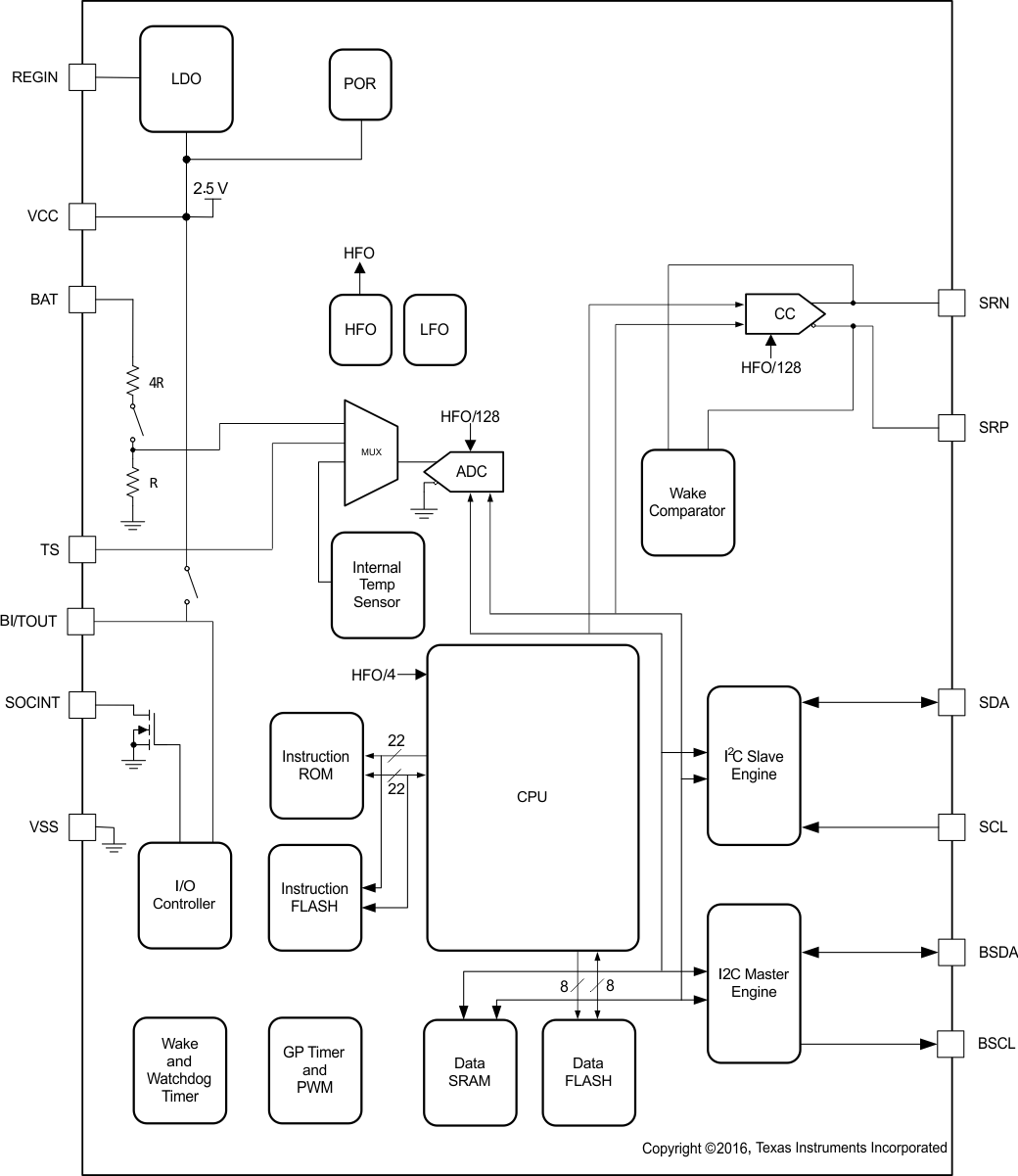
7.3 Feature Description
Information is accessed through a series of commands, called Standard Commands. Further capabilities are provided by the additional Extended Commands set. Both sets of commands, indicated by the general format Command(), are used to read and write information contained within the control and status registers, as well as its data flash locations. Commands are sent from system to gauge using the I2C serial communications engine, and can be executed during application development, pack manufacture, or end-equipment operation.
Cell information is stored in non-volatile flash memory. Many of these data flash locations are accessible during application development. They cannot, generally, be accessed directly during end-equipment operation. Access to these locations is achieved by either use of the companion evaluation software, through individual commands, or through a sequence of data-flash-access commands. To access a desired data flash location, the correct data flash subclass and offset must be known.
The key to the high-accuracy gas gauging prediction is the TI proprietary Impedance Track™ algorithm. This algorithm uses cell measurements, characteristics, and properties to create SOC predictions that can achieve less than 1% error across a wide variety of operating conditions and over the lifetime of the battery.
The fuel gauge measures the charging and discharging of the battery by monitoring the voltage across a small-value series sense resistor (5 to 20 mΩ, typical) located between the system VSS and the battery PACK– terminal. When a cell is attached to the fuel gauge, cell impedance is computed, based on cell current, cell open-circuit voltage (OCV), and cell voltage under loading conditions.
The external temperature sensing is optimized with the use of a high-accuracy negative temperature coefficient (NTC) thermistor with R25 = 10.0 kΩ ±1%, B25/85 = 3435 K ± 1% (such as Semitec NTC 103AT). The fuel gauge can also be configured to use its internal temperature sensor. When an external thermistor is used, a 18.2-kΩ pullup resistor between the BI/TOUT and TS pins is also required. The fuel gauge uses temperature to monitor the battery-pack environment, which is used for fuel gauging and cell protection functionality.
To minimize power consumption, the fuel gauge has different power modes: NORMAL, SLEEP, SLEEP+, HIBERNATE, and BAT INSERT CHECK. The fuel gauge passes automatically between these modes, depending upon the occurrence of specific events, though a system processor can initiate some of these modes directly.
7.3.1 Functional Description
The fuel gauge measures the cell voltage, temperature, and current to determine battery SOC. The fuel gauge monitors the charging and discharging of the battery by sensing the voltage across a small-value resistor (5 mΩ to 20 mΩ, typical) between the SRP and SRN pins and in series with the cell. By integrating charge passing through the battery, the battery SOC is adjusted during battery charge or discharge.
The total battery capacity is found by comparing states of charge before and after applying the load with the amount of charge passed. When an application load is applied, the impedance of the cell is measured by comparing the OCV obtained from a predefined function for present SOC with the measured voltage under load. Measurements of OCV and charge integration determine chemical SOC and chemical capacity (Qmax). The initial Qmax values are taken from a cell manufacturers' data sheet multiplied by the number of parallel cells. It is also used for the value in Design Capacity. The fuel gauge acquires and updates the battery-impedance profile during normal battery usage. It uses this profile, along with SOC and the Qmax value, to determine FullChargeCapacity() and StateOfCharge(), specifically for the present load and temperature. FullChargeCapacity() is reported as capacity available from a fully-charged battery under the present load and temperature until Voltage() reaches the Terminate Voltage. NominalAvailableCapacity() and FullAvailableCapacity() are the uncompensated (no or light load) versions of RemainingCapacity() and FullChargeCapacity(), respectively.
The fuel gauge has two flags accessed by the Flags() function that warn when the battery SOC has fallen to critical levels. When RemainingCapacity() falls below the first capacity threshold as specified in SOC1 Set Threshold, the [SOC1] (State of Charge Initial) flag is set. The flag is cleared once RemainingCapacity() rises above SOC1 Clear Threshold.
When the voltage is discharged to Terminate Voltage, the SOC will be set to 0.
7.4 Device Functional Modes
7.4.1 Power Modes
The fuel gauge has different power modes:
- BAT INSERT CHECK: The BAT INSERT CHECK mode is a powered-up, but low-power halted, state where the fuel gauge resides when no battery is inserted into the system.
- NORMAL: In NORMAL mode, the fuel gauge is fully powered and can execute any allowable task.
- SLEEP: In SLEEP mode, the fuel gauge turns off the high-frequency oscillator and exists in a reduced- power state, periodically taking measurements and performing calculations.
- SLEEP+: In SLEEP+ mode, both low-frequency and high-frequency oscillators are active. Although the SLEEP+ mode has higher current consumption than the SLEEP mode, it is also a reduced power mode.
- HIBERNATE: In HIBERNATE mode, the fuel gauge is in a low power state, but can be woken up by communication or certain I/O activity.
The relationship between these modes is shown in Figure 6.
7.4.1.1 BAT INSERT CHECK Mode
This mode is a halted-CPU state that occurs when an adapter, or other power source, is present to power the fuel gauge (and system), yet no battery has been detected. When battery insertion is detected, a series of initialization activities begin, which include: OCV measurement, setting the Flags() [BAT_DET] bit, and selecting the appropriate battery profiles.
Some commands, issued by a system processor, can be processed while the fuel gauge is halted in this mode. The gauge wakes up to process the command, then returns to the halted state awaiting battery insertion.
7.4.1.2 NORMAL Mode
The fuel gauge is in NORMAL mode when not in any other power mode. During this mode, AverageCurrent(), Voltage(), and Temperature() measurements are taken, and the interface data set is updated. Decisions to change states are also made. This mode is exited by activating a different power mode.
Because the gauge consumes the most power in NORMAL mode, the Impedance Track algorithm minimizes the time the fuel gauge remains in this mode.
7.4.1.3 SLEEP Mode
SLEEP mode is entered automatically if the feature is enabled (Op Config [SLEEP] = 1) and AverageCurrent() is below the programmable level Sleep Current . Once entry into SLEEP mode has been qualified, but prior to entering it, the fuel gauge performs a coulomb counter autocalibration to minimize offset.
During SLEEP mode, the fuel gauge periodically takes data measurements and updates its data set. However, a majority of its time is spent in an idle condition.
The fuel gauge exits SLEEP mode if any entry condition is broken, specifically when:
- AverageCurrent() rises above Sleep Current , or
- A current in excess of IWAKE through RSENSE is detected.
In the event that a battery is removed from the system while a charger is present (and powering the gauge), Impedance Track updates are not necessary. Hence, the fuel gauge enters a state that checks for battery insertion and does not continue executing the Impedance Track algorithm.
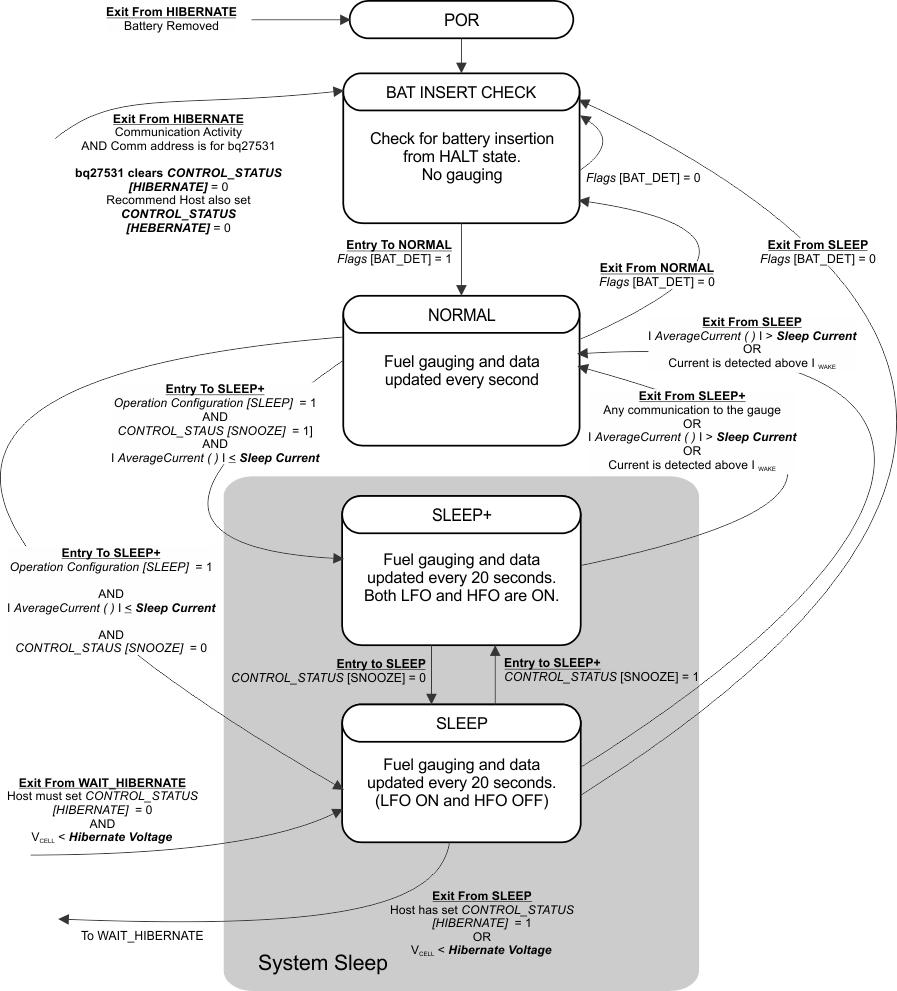 Figure 6. Power Mode Diagram—System Sleep
Figure 6. Power Mode Diagram—System Sleep
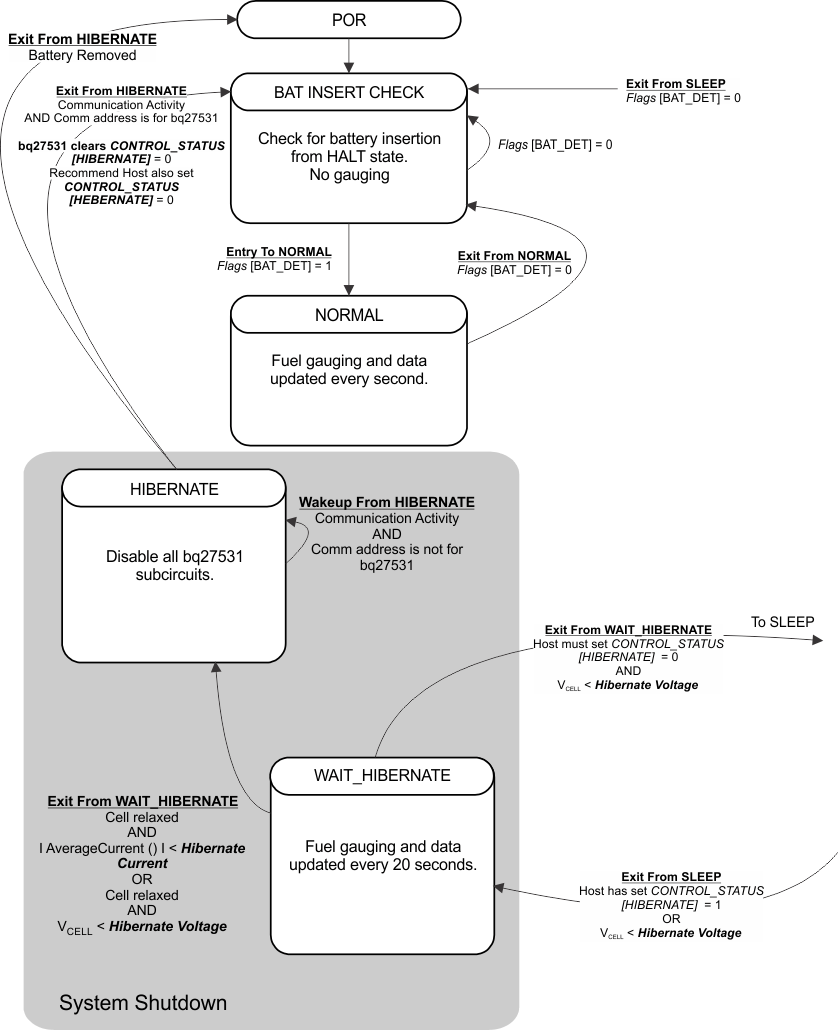 Figure 7. Power Mode Diagram—System Shutdown
Figure 7. Power Mode Diagram—System Shutdown
7.4.2 SLEEP+ Mode
Compared to the SLEEP mode, SLEEP+ mode has the high-frequency oscillator in operation. The communication delay could be eliminated. The SLEEP+ mode is entered automatically if the feature is enabled (CONTROL_STATUS [SNOOZE] = 1) and AverageCurrent() is below the programmable level Sleep Current.
During SLEEP+ mode, the fuel gauge periodically takes data measurements and updates its data set. However, a majority of its time is spent in an idle condition.
The fuel gauge exits SLEEP+ mode if any entry condition is broken, specifically when:
- Any communication activity with the gauge, or
- AverageCurrent() rises above Sleep Current, or
- A current in excess of IWAKE through RSENSE is detected.
7.4.3 HIBERNATE Mode
HIBERNATE mode should be used when the system equipment needs to enter a low-power state, and minimal gauge power consumption is required. This mode is ideal when system equipment is set to its own HIBERNATE, SHUTDOWN, or OFF mode.
Before the fuel gauge can enter HIBERNATE mode, the system must set the CONTROL_STATUS [HIBERNATE] bit. The gauge waits to enter HIBERNATE mode until it has taken a valid OCV measurement and the magnitude of the average cell current has fallen below Hibernate Current. The gauge can also enter HIBERNATE mode if the cell voltage falls below Hibernate Voltage and a valid OCV measurement has been taken. The gauge remains in HIBERNATE mode until the system issues a direct I2C command to the gauge or a POR occurs. Any I2C communication that is not directed to the gauge does not wake the gauge.
It is the responsibility of the system to wake the fuel gauge after it has gone into HIBERNATE mode. After waking, the gauge can proceed with the initialization of the battery information (OCV, profile selection, and so forth).
7.5 Programming
7.5.1 Standard Data Commands
The bq27530-G1 uses a series of 2-byte standard commands to enable system reading and writing of battery information. Each standard command has an associated command-code pair, as indicated in Table 1. Because each command consists of two bytes of data, two consecutive I2C transmissions must be executed both to initiate the command function, and to read or write the corresponding two bytes of data.
Table 1. Standard Commands
| NAME | COMMAND CODE | UNITS | SEALED ACCESS | UNSEALED ACCESS | |
|---|---|---|---|---|---|
| Control() | 0x00/0x01 | N/A | R/W | R/W | |
| AtRate() | 0x02/0x03 | mA | R/W | R/W | |
| AtRateTimeToEmpty() | 0x04/0x05 | Minutes | R | R/W | |
| Temperature() | 0x06/0x07 | 0.1 K | R/W | R/W | |
| Voltage() | 0x08/0x09 | mV | R | R/W | |
| Flags() | 0x0a/0x0b | N/A | R | R/W | |
| NominalAvailableCapacity() | 0x0c/0x0d | mAh | R | R/W | |
| FullAvailableCapacity() | 0x0e/0x0f | mAh | R | R/W | |
| RemainingCapacity() | 0x10/0x11 | mAh | R | R/W | |
| FullChargeCapacity() | 0x12/0x13 | mAh | R | R/W | |
| AverageCurrent() | 0x14/0x15 | mA | R | R/W | |
| TimeToEmpty() | 0x16/0x17 | Minutes | R | R/W | |
| RemainingCapacityUnfiltered() | 0x18/0x19 | mAh | R | R/W | |
| StandbyCurrent() | 0x1a/0x1b | mA | R | R/W | |
| RemainingCapacityFiltered() | 0x1c/0x1d | mAh | R | R/W | |
| ProgChargingCurrent() | 0x1e/0x1f | mA | R(1) | R(1) | |
| ProgChargingVoltage() | 0x20/0x21 | mV | R(1) | R(1) | |
| FullChargeCapacityUnfiltered() | 0x22/0x23 | mAh | R | R/W | |
| AveragePower() | 0x24/0x25 | mW | R | R/W | |
| FullChargeCapacityFiltered() | 0x26/0x27 | mAh | R | R/W | |
| StateOfHealth() | 0x28/0x29 | %/num | R | R/W | |
| CycleCount() | 0x2a/0x2b | Counters | R | R/W | |
| StateOfCharge() | 0x2c/0x2d | % | R | R/W | |
| TrueSOC() | 0x2e/0x2f | % | R | R/W | |
| InstantaneousCurrentReading() | 0x30/0x31 | mA | R | R/W | |
| InternalTemperature() | 0x32/0x33 | 0.1 K | R | R/W | |
| ChargingLevel() | 0x34/0x35 | HEX | R | R | |
| LevelTaperCurrent() | 0x6e/0x6f | mA | R | R | |
| CalcChargingCurrent() | 0x70/0x71 | mA | R | R | |
| CalcChargingVoltage() | 0x72/0x73 | V | R | R | |
7.5.2 Control(): 0x00/0x01
Issuing a Control() command requires a subsequent 2-byte subcommand. These additional bytes specify the particular control function desired. The Control() command allows the system to control specific features of the bq27530-G1 during normal operation and additional features when the device is in different access modes, as described in Table 2.
Table 2. Control( ) Subcommands
| CNTL FUNCTION | CNTL DATA |
SEALED ACCESS |
DESCRIPTION |
|---|---|---|---|
| CONTROL_STATUS | 0x0000 | Yes | Reports the status of hibernate, IT, and so on |
| DEVICE_TYPE | 0x0001 | Yes | Reports the device type (for example: bq27530) |
| FW_VERSION | 0x0002 | Yes | Reports the firmware version on the device type |
| HW_VERSION | 0x0003 | Yes | Reports the hardware version of the device type |
| PREV_MACWRITE | 0x0007 | Yes | Returns previous MAC subcommand code |
| CHEM_ID | 0x0008 | Yes | Reports the chemical identifier of the Impedance Track™ configuration |
| BOARD_OFFSET | 0x0009 | No | Forces the device to measure and store the board offset |
| CC_OFFSET | 0x000a | No | Forces the device to measure the internal CC offset |
| CC_OFFSET_SAVE | 0x000b | No | Forces the device to store the internal CC offset |
| OCV_CMD | 0x000c | Yes | Request the gauge to take a OCV measurement |
| BAT_INSERT | 0x000d | Yes | Forces the BAT_DET bit set when the [BIE] bit is 0 |
| BAT_REMOVE | 0x000e | Yes | Forces the BAT_DET bit clear when the [BIE] bit is 0 |
| SET_HIBERNATE | 0x0011 | Yes | Forces CONTROL_STATUS [HIBERNATE] to 1 |
| CLEAR_HIBERNATE | 0x0012 | Yes | Forces CONTROL_STATUS [HIBERNATE] to 0 |
| SET_SLEEP+ | 0x0013 | Yes | Forces CONTROL_STATUS [SNOOZE] to 1 |
| CLEAR_SLEEP+ | 0x0014 | Yes | Forces CONTROL_STATUS [SNOOZE] to 0 |
| DIV_CUR_ENABLE | 0x0017 | Yes | Makes the programmed charge current to be half of what is calculated by the gauge charging algorithm. |
| CHG_ENABLE | 0x001A | Yes | Enable charger. Charge will continue as dictated by gauge charging algorithm. |
| CHG_DISABLE | 0x001B | Yes | Disable charger (Set CE bit of bq2416x) |
| GG_CHGRCTL_ENABLE | 0x001C | Yes | Enables the gas gauge to control the charger while continuosly resetting the charger watchdog |
| GG_CHGRCTL_DISABLE | 0x001D | Yes | The gas gauge stops resetting the charger watchdog |
| DIV_CUR_DISABLE | 0x001E | Yes | Makes the programmed charge current to be same as what is calculated by the gauge charging algorithm. |
| DF_VERSION | 0x001F | Yes | Returns the Data Flash Version |
| SEALED | 0x0020 | No | Places device in SEALED access mode |
| IT_ENABLE | 0x0021 | No | Enables the Impedance Track™ algorithm |
| RESET | 0x0041 | No | Forces a full reset of the bq27530-G1 |
7.5.3 Communications
7.5.3.1 I2C Interface
The bq27530-G1 supports the standard I2C read, incremental read, quick read, one-byte write, and incremental write functions. The 7-bit device address (ADDR) is the most significant 7 bits of the hex address and is fixed as 1010101. The first 8 bits of the I2C protocol are, therefore, 0xAA or 0xAB for write or read, respectively.
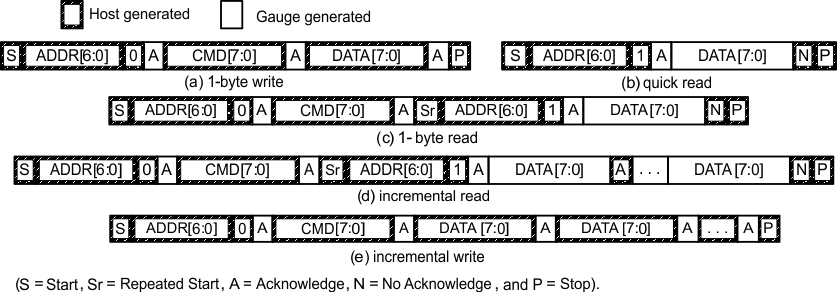
The quick read returns data at the address indicated by the address pointer. The address pointer, a register internal to the I2C communication engine, increments whenever data is acknowledged by the bq27530-G1 or the I2C master. “Quick writes” function in the same manner and are a convenient means of sending multiple bytes to consecutive command locations (such as two-byte commands that require two bytes of data).
The following command sequences are not supported:
- Attempt to write a read-only address (NACK after data sent by master):
- Attempt to read an address above 0x6B (NACK command):


7.5.3.2 I2C Time Out
The I2C engine releases both SDA and SCL if the I2C bus is held low for 2 seconds. If the bq27530-G1 is holding the lines, releasing them frees them for the master to drive the lines. If an external condition is holding either of the lines low, the I2C engine enters the low-power sleep mode.
7.5.3.3 I2C Command Waiting Time
To ensure proper operation at 400 kHz, a t(BUF) ≥ 66 μs bus-free waiting time must be inserted between all packets addressed to the bq27530-G1. In addition, if the SCL clock frequency (fSCL) is > 100 kHz, use individual 1-byte write commands for proper data flow control. Figure 8 shows the standard waiting time required between issuing the control subcommand the reading the status result. A DF_CHECKSUM subcommand requires 100 ms minimum prior to reading the result. An OCV_CMD subcommand requires 1.2 seconds prior to reading the result. For read-write standard command, a minimum of 2 seconds is required to get the result updated. For read-only standard commands, there is no waiting time required, but the host must not issue any standard command more than two times per second. Otherwise, the gauge could result in a reset issue due to the expiration of the watchdog timer.
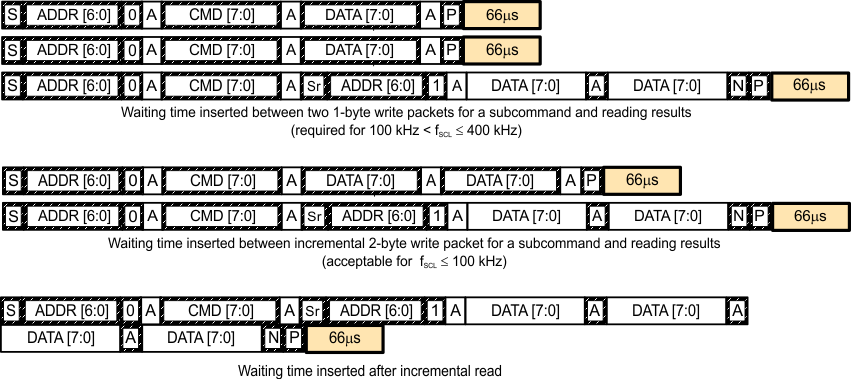 Figure 8. Standard Waiting Time
Figure 8. Standard Waiting Time
7.5.3.4 I2C Clock Stretching
A clock stretch can occur during all modes of fuel gauge operation. In SLEEP and HIBERNATE modes, a short clock stretch occurs on all I2C traffic as the device must wake-up to process the packet. In the other modes (BAT INSERT CHECK, NORMAL, SLEEP+) clock stretching only occurs for packets addressed for the fuel gauge. The majority of clock stretch periods are small as the I2C interface performs normal data flow control. However, less frequent yet more significant clock stretch periods may occur as blocks of Data Flash are updated. Table 3 summarizes the approximate clock stretch duration for various fuel gauge operating conditions.
Table 3. Approximate Clock Stretch Duration
| GAUGING MODE | OPERATING CONDITION/COMMENT | APPROXIMATE DURATION |
|---|---|---|
| SLEEP HIBERNATE |
Clock stretch occurs at the beginning of all traffic as the device wakes up. | ≤ 4 ms |
| BAT INSERT CHECK NORMAL SLEEP+ | Clock stretch occurs within the packet for flow control (after a start bit, ACK or first data bit). | ≤ 4 ms |
| Normal Ra table Data Flash updates. | 24 ms | |
| Data Flash block writes. | 72 ms | |
| Restored Data Flash block write after loss of power. | 116 ms | |
| End of discharge Ra table Data Flash update. | 144 ms |